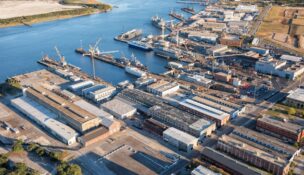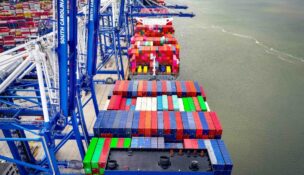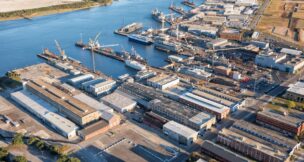Supply chain woes creating crunch on land and at sea
Contributing Writer //November 29, 2021//
By Christina Lee Knauss
Images of packed container ships waiting for weeks to get into ports on the West Coast have been in the news for the past few months, highlighting an issue that is reaching into nearly every industry and home in the U.S.: a massive supply chain crunch as the Christmas holiday nears.
A multitude of factors is causing the supply chain issues. U.S. consumers are buying goods at record levels, many of them produced overseas. The continuing pandemic has resulted in employee shortages and slowdowns at many overseas factories, creating longer wait times for shipments of everything from consumer goods to products needed by manufacturers, high tech industries and other sectors.
Finally, when the goods do get here, ports on the West Coast are backed up because of a shortage of longshoremen to unload the ships and an even more drastic shortage of available trucks and drivers to transport the shipments.
The East Coast, South Carolina included, isn’t seeing the kind of backups being experienced at ports in Los Angeles and Long Beach, Calif., but the effects are being felt here as well, according to those involved with shipping and transportation in the state.
Imports to the Port of Charleston were up 12% year-over-year in October as the port continues to take in more retail goods than ever before, according to Liz Crumley, manager of corporate communications for the South Carolina Ports Authority. Recent reports show that furniture imports into Charleston are up 55% year over year, and SC Ports has handled record cargo volumes – both imports and exports combined – for the past eight months.
Crumley said the dramatic increase in workload at the port hasn’t caused any severe backups, largely because of a $2 billion investment in infrastructure in recent years that increased capacity. Some examples include modernization efforts to enable the Wando Welch Terminal to handle more cargo and bigger ships and the expansion of Inland Port Greer, which is served by rail.
Charleston also has the advantage of being the only port in the U.S. with new terminal capacity, added with the opening of phase one of the Leatherman Terminal in 2021. The expansion added more than 700,000 TEUs of capacity — a measure of volume in units of 20-foot-long shipping containers — as well as an additional berth that can accommodate mega container ships.
With forecasts showing that consumer demand is likely to remain strong for months, the Charleston port is likely to continue to see record volumes, especially retail. That amount will increase even more when Walmart opens a nearly 3-million-square-foot import distribution center in Ridgeville in early 2022, a project expected to create 1,000 jobs and boost import volumes at the port by 5%.
While things at the port are moving smoothly for the most part, another industry that works hand-in-hand with the import industry is facing the brunt of the supply chain crunch.
Trucking – the industry responsible for getting two-thirds of the country’s freight to where it needs to go – is facing the worst driver shortage on record, according to statistics released by the American Trucking Association. The country currently has a shortage of about 80,000 truck drivers, a figure that has increased about 30% from before the pandemic.
The shortage is caused by an increase in the number of trucker retirements as well as a significant number of drivers who have left the nationwide fleet for other careers. Safety and salary concerns and the long stretches away from home that come with a lot of commercial trucking jobs are keeping many potential employees away, industry leaders say.
“Every sector of the economy is different, but the constant is the truck and the driver,” said J. Richards Todd, president and CEO of the South Carolina Trucking Association. “When we are short drivers, plus technicians and component parts to keep them running, that equates to a shortage of trucking capacity. Our economy is absolutely truck-dependent, and that will not change.”
Leaders at Forward Air, one of the largest trucking companies transporting freight from the Charleston port, would like to grow its presence in the Charleston area because of the smooth operations at the port, but the driver shortage is preventing desired expansion, according to CEO Thomas Schmitt.
As a result, the company is doing everything possible to attract new drivers and keep its current ones, including forming a 12-member Drivers’ Board which meets quarterly to address the concerns of the company’s drivers.
“We’re doing everything we can to be more creative and safely onboard more employees, but I’m afraid the war for talent is going to be a long war, and it’s not going to get easier any time soon,” Schmitt said.
Trucking, like other industries, is finding that a hands-on approach can work to attract employees. The industry in South Carolina, through the Associated Industries of South Carolina Foundation, has formed a workforce development program called Be Pro Be Proud to draw high school students and other job seekers to trucking and other skilled professions.
The SCTA has provided a tractor and custom-built trailer fitted with virtual reality stations and simulators representing the different skilled trades involved in the trucking industry. The mobile workshop travels to high schools, tech schools and other job development facilities around the state to promote the careers, and is often booked more than a year out.
Todd said the SCTA is also working to help build a high school curriculum that could be called CDL Prep, with coursework that would help prepare students for the trucking industry before they turn 18.
“If this is a career they want to pursue, we want them to get a head start,” he said.
Getting young people excited about the trucking industry is one of the primary goals of Tra Williams, CEO of Fleetforce Truck Driving School, which currently operates in Florida. Williams said he also hopes to open Fleetforce’s first school in South Carolina in the Charleston area by 2022.
“The main challenge for the industry is to remove the stigma that being a professional driver is a low-skill, low-education and low-wage opportunity,” Williams said. “Nothing could be further from the truth. The demand for experienced professional drives cannot be overstated.”
F

















